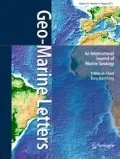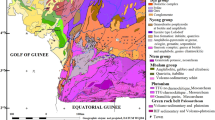Abstract
Free-air gravity and bathymetric maps are routinely used for large-scale geological studies but rugged topography and varying shallow-depth conditions can complicate their usefulness in geological interpretations. It is crucial to reduce the gravity anomaly map to a common datum for regional correlation studies so that Bouguer anomalies can be more confidently interpreted to reveal subsurface bodies of exploration interest. However, Bouguer anomaly computation requires a precise knowledge of the shallow-depth density variation, while direct measurement of the near-surface density at every observation station is not feasible. A simple, objective indirect method for estimating the optimum density for Bouguer reduction is desirable. Using data from the Hotspur seamount and the Santos Basin offshore south-eastern Brazil, it is shown that correlating bathymetry and computed Bouguer anomaly for a range of densities provides a simple means for selecting the optimal density for Bouguer reduction. Unlike previous approaches, the use of angular differences between the gradients of bathymetric and Bouguer gravity maps is proposed to select the optimum density for reduction. Their standard deviations clearly define a minimum when the maps are least correlated, providing an objective metric for determining the optimum density for large-scale regional Bouguer reduction. The results improve the delineation of major features such as the Santos hinge line and the landward limit of the salt province in the Santos Basin.





Similar content being viewed by others
References
Alves CE, Maia M, Sichel SE, Pinheiro de Campos CM (2006) Zona de fratura de Vitória-Trindade no Oceano Atlântico sudeste e suas implicações tectônicas (in Portuguese with English abstract). Rev Bras Geofis 24(1):117–127. doi:10.1590/S0102-261X2006000100009
Audet P, Mareschal J-C (2007) Wavelet analysis of the coherence between Bouguer gravity and topography: application to the elastic thickness anisotropy in the Canadian Shield. Geophys J Int 168(1):287–298
Bizzi LA, Schobbenhaus C, Vidotti RM, Gonçalves JH (2003) Geologia, tectônica e recursos minerais do Brasil: texto, mapas SIG. CPRM, Serviço Geológico do Brasil
Caratori Tontini F, Graziano F, Cocchi L, Carmisciano C, Stefanelli P (2007) Determining the optimal Bouguer density for a gravity data-set: implications for the isostatic setting of the Mediterranean Sea. Geophys J Int 169:380–388. doi:10.1111/j.1365-246X.2007.03340.x
Chapin DA (1996) A deterministic approach toward isostatic gravity residuals: a case study from South America. Geophysics 61(4):1022–1033
Davison I (1999) Tectonics and hydrocarbon distribution along the Brazilian South Atlantic margin. In: Cameron NR, Bate RH, Clure VS (eds) Oil and gas habitats of the South Atlantic. Geol Soc Lond Spec Publ 153:133–151
Davison I (2007) Geology and tectonics of the South Atlantic Brazilian salt basins. Geol Soc Lond Spec Publ 272:345–359
Ferrari AL, Riccomini C (1999) Campo de esforços plio-pleistocênico na Ilha de Trindade (Oceano Atlântico Sul, Brasil), e sua relação com a tectônica regional (in Portuguese with English abstract). Rev Bras Geociên 29(2):293–300
Filho AT, de Cesero P, Mizusaki AM, Gisbert Leão J (2005) Hot spot volcanic tracks and their implications for south American plate motion, Campos basin (Rio de Janeiro state), Brazil. J South Am Earth Sci 18(3/4):383–389
Gallardo LA, Meju MA (2011) Structure-coupled multi-physics imaging in geophysical sciences. Rev Geophys 49:RG1003. doi:10.1029/2010RG000330
Garcia SFM, Letouzey J, Rudkiewicz J-L, Danderfer Filho A, Frizon de Lamotte D (2012) Structural modeling based on sequential restoration of gravitational salt deformation in the Santos Basin (Brazil). Mar Petrol Geol 35(1):337–353
Göttl F, Rummel R (2009) A geodetic view on isostatic models. Pure Appl Geophys 166(8/9):1247–1260
Hinze WJ (2003) Bouguer reduction density, why 2.67? Geophysics 68(5):1559–1560
Hinze WJ, Aiken C, Brozena J, Coakley B, Dater D et al (2005) New standards for reducing gravity data: the North America gravity database. Geophysics 70(4):J25–J32
Jacoby W, Smilde PL (2009) Gravity interpretation - Fundamentals and application of gravity inversion and geological interpretation. Springer, Heidelberg
Jilinski P, Fontes S, Gallardo LA (2010) Joint interpretation of maps using gradient directions, cross and dot-product values to determine correlations between bathymetric and gravity anomaly maps. SEG Expanded Abstr 29:1226. doi:10.1190/1.3513066
Karner GD, Driscoll NW (1999) Tectonic and stratigraphic development of the West African and eastern Brazilian margins: insights from quantitative basin modelling. Geol Soc Lond Spec Publ 153:11–40. doi:10.1144/GSL.SP.1999.153.01.02
McKenzie D, Bowin C (1976) The relationship between bathymetry and gravity in the Atlantic Ocean. J Geophys Res 81:1903–1915
Moore ID, Lewis A, Gallant JC (1993) Terrain attributes: estimation methods and scale effects. In: Jakeman AJ, Beck MB, McAleer M (eds) Modelling change in environmental systems. Wiley, Chichester, pp 189–214
Naidu PS, Mathew MP (1998) Analysis of geophysical potential fields. A. Digital signal processing approach. Elsevier, Amsterdam
Nettleton LL (1939) Determination of density for reduction of gravimeter observations. Geophysics 4(3):176–183
Pawlowski R (2008) The use of gravity anomaly data for offshore continental margin demarcation. Lead Edge 27(6):722. doi:10.1190/1.2944156
Saha D, Chatterjee SM, Baruah BN (2006) Determination of optimum average density for Bouguer correction – a case study in Tirasujanpur area, Himachal Pradesh, India. In: Contributions 6th Int Conf & Expo Petroleum Geophysics, Calcutta 2006, pp 89–93. Society of Petroleum Geophysicists India, Dehradun, www.spgindia.org/2006/304.pdf
Sandwell DT, Smith WHF (2009) Global marine gravity from retracked Geosat and ERS-1 altimetry: ridge segmentation versus spreading rate. J Geophys Res 114:B01411. doi:10.1029/2008JB006008
Smith WHF, Sandwell DT (1997) Global seafloor topography from satellite altimetry and ship depth soundings. Science 277:1957–1962
Stanton N, Schmitt R, Galdeano A, Maia M, Mane M (2010) Crustal structure of the southeastern Brazilian margin, Campos Basin, from aeromagnetic data: new kinematic constraints. Tectonophysics 490(1/2):15–27
Vajk R (1956) Bouguer corrections with varying surface density. Geophysics 21:1004–1020
Watts AB (2001) Isostasy and flexure of the lithosphere. Cambridge University Press, Cambridge
Acknowledgments
CNPq is thanked for providing Pavel Jilinski a postgraduate scholarship. The support of MCT-ON is also acknowledged. Constructive comments by F. Caratori Tontini, an anonymous reviewer and the journal editors proved useful in improving the manuscript.
Author information
Authors and Affiliations
Corresponding author
Rights and permissions
About this article
Cite this article
Jilinski, P., Fontes, S.L. & Meju, M.A. Estimating optimum density for regional Bouguer reduction by morphological correlation of gravity and bathymetric maps: examples from offshore south-eastern Brazil. Geo-Mar Lett 33, 67–73 (2013). https://doi.org/10.1007/s00367-012-0312-0
Received:
Accepted:
Published:
Issue Date:
DOI: https://doi.org/10.1007/s00367-012-0312-0




